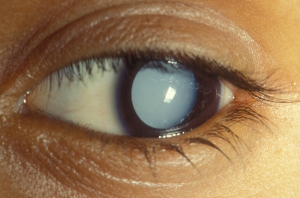
It may come as a surprise to many that among all of the blinding conditions that exist, cataracts are the leading cause of preventable blindness worldwide. Unfortunately, those who suffer from cataracts in developing nations may not have the access to care and the technology required to diagnose and treat cataracts. Surgical procedures to remove cataracts have evolved considerably and can literally restore vision, within minutes, to individuals who have gone blind from advanced cataracts.
USC Roski Eye institute physicians specializing in cataract surgery have joined forces with international charitable organizations to provide their services. “I feel privileged and honored to be able to use my expertise and training in cataract surgery to restore vision to those blinded by cataracts,” said Jonathan Song, MD, associate professor of clinical ophthalmology at the USC Roski Eye Institute and director of the cataract service. “In my travels to countries like Fiji, Nicaragua, Indonesia, Malaysia, India, China, Mexico and Latvia, there are no words to describe the impact cataract surgery has on the people I have operated on. Loss of vision can mean a loss of life. People depend on their sight to earn a living and provide for their families,” explains Song.
Our cataract surgeons want you to be aware of the causes, symptoms and treatments available for cataracts. The USC Roski Eye Institute’s Cataract Service is proud to provide the most advanced technology and expertise in cataract removal and intraocular lens replacement.
What is a cataract?
A cataract results when the natural lens of the eye becomes cloudy and impedes light from entering the eye. The lens is a transparent structure found in the eye that helps bend light to allow it to be precisely focused on the retina. Cataracts generally occur in those over the age of 50, but may be congenital or result from trauma, or specific diseases. The only available treatment for cataracts is surgical removal of the lens and replacement with an intraocular lens implant.
Symptoms of cataracts
- Decreasing vision with age
- Blurred or double vision
- Seeing halos around bright lights
- Difficulty distinguishing colors
- Frequent prescription changes for glasses
- Difficulty reading
Causes of cataracts
- Age
- Eye trauma
- Diabetes
- Smoking
- Glaucoma
- Some medications including long-term use of oral steroids
- Sun Exposure
Cataract surgery: An outpatient procedure
A couple of decades ago, cataract surgery was still considered high risk and associated with long recovery times. Today, cataract surgery is an outpatient procedure, which can even allow a patient to operate a vehicle one day after surgery. The procedure itself is extremely safe —involving a microscopic incision through which the cataract is removed and a foldable intraocular lens (IOL) is implanted to replace the clouded lens. The diminished recovery time is the result of the rapid healing of the tiny incision that is made during the time of surgery.
Custom laser cataract surgery: A major advancement in cataract removal
The USC Roski Eye Institute’s Cataract Service also offers Custom Laser Cataract Surgery, which involves the use of a femtosecond laser to perform essential components of the procedure. Unlike a surgical blade used during traditional cataract surgeries, the advanced technology of a femtosecond laser is effectively able to create a corneal incision, open the lens capsule, and fragment the cataract into small pieces without entering the eye. The laser surgery goes beyond traditional cataract surgery as it allows surgeons to perform additional procedures during the time of cataract removal, resulting in improved vision and less dependence on glasses or bifocals. For example, the laser technique can allow for surgeons to carry out treatment of presbyopia and astigmatism, during the surgical procedure.
This technique is highly advantageous to those who have ocular diseases like glaucoma as well. “We are fortunate that the femtosecond laser technology at the USC Roski Eye Institute has become available to patients with glaucoma. It gives predictable results and does not lead to elevation in eye pressure during post operative recovery,” said Alena Reznik, MD, assistant professor of clinical ophthalmology at the institute. “Remarkably, we are also able to perform minimally invasive glaucoma surgery at the same time as femtosecond cataract extraction to further decrease recovery time, use of general anesthesia and glaucoma drops in the future,” said Reznik, who is also part of the Glaucoma service.
by Debbie Mitra
Our trusted ophthalmologists at the USC Roski Eye Institute are fellowship-trained specialists who provide the most cutting-edge technology in the treatment of cataract removal.
To make an appointment at the USC Roski Eye Institute, please call (323) 442-6335 or contact us to schedule a consultation today.
Topics
